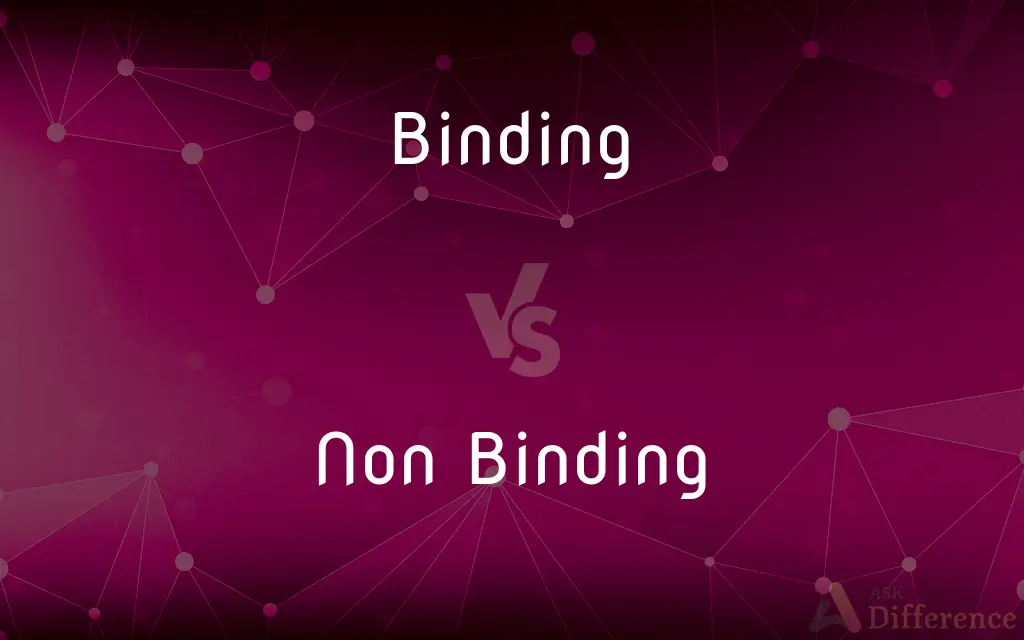Binding vs. Non Binding — What's the Difference?
By Tayyaba Rehman & Maham Liaqat — Published on March 3, 2024
Binding refers to agreements or decisions that are legally enforceable, while non-binding ones are not legally enforceable and serve as a statement of intent or a preliminary agreement.

Difference Between Binding and Non Binding
Table of Contents
ADVERTISEMENT
Key Differences
Binding agreements are formal and enforceable by law, meaning that the parties involved have specific obligations that, if unmet, can lead to legal consequences. These agreements are common in contracts where clear commitments are made, and failure to comply can result in lawsuits or other legal actions. Examples include employment contracts, lease agreements, and purchase contracts, where each party's duties and rights are clearly defined and protected under the law.
Non-binding agreements, on the other hand, are more informal and serve as a mutual understanding or intention between parties without legal obligations. They are often used in the early stages of negotiations or as a way to outline the terms of a potential agreement before entering into a binding contract. Non-binding agreements are useful for discussions and planning but do not hold any party legally accountable for non-compliance. Examples include letters of intent, memorandums of understanding, and certain types of gentlemen’s agreements.
The key distinction lies in the legal enforceability and the consequences of not adhering to the agreement. Binding agreements require adherence to their terms, with legal systems providing mechanisms for enforcement and dispute resolution. Non-binding agreements, while reflecting a consensus or intention, lack these legal frameworks for enforcement, making them more flexible but less secure in terms of guaranteeing outcomes.
Choosing between a binding and non-binding agreement depends on the situation and the level of commitment desired by the parties involved. For formal relationships with clear expectations and protections, a binding agreement is appropriate. For exploratory discussions or when flexibility is needed without legal commitment, a non-binding agreement may be preferred.
Comparison Chart
Legal Enforceability
Legally enforceable
Not legally enforceable
ADVERTISEMENT
Purpose
Formalize obligations and rights
Outline intentions or preliminary terms
Consequences of Breach
Legal consequences (e.g., lawsuits)
No legal consequences
Examples
Employment contracts, lease agreements
Letters of intent, memorandums of understanding
Use Case
When clear commitments are required
Early negotiations or when flexibility is needed
Compare with Definitions
Binding
Legally enforceable by law.
The lease agreement is binding, requiring tenants to pay monthly rent.
Non Binding
Serves as a statement of intent or mutual understanding.
They signed a non-binding memorandum of understanding to explore a partnership.
Binding
Involves clear obligations and rights.
The binding contract specifies the delivery dates for the goods.
Non Binding
Reflects a consensus or intention without commitment.
The non-binding agreement allows flexibility as negotiations continue.
Binding
Can lead to legal consequences if breached.
Failing to comply with the binding nondisclosure agreement could result in litigation.
Non Binding
Lacks legal enforceability.
The letter of intent is non-binding, so it's a preliminary agreement before the final deal.
Binding
Used for formal and secure agreements.
They entered into a binding sales contract after negotiations.
Non Binding
No legal consequences for non-compliance.
Non-compliance with the terms of the non-binding agreement doesn’t lead to legal action.
Binding
Enforced by legal systems.
The arbitration clause in the binding agreement specifies how disputes will be resolved.
Non Binding
Often used in early stages of negotiation.
The non-binding proposal helps both parties understand the potential terms.
Binding
Imposing or commanding adherence to a commitment, an obligation, or a duty
Binding arbitration.
A binding agreement.
Non Binding
(legal) That does not bind the participants
Binding
(of an agreement, contract, etc.) Imposing stipulations or requirements that must be honoured.
This contract is a legally binding agreement.
Non Binding
(chemistry) Not involved in the formation of bonds
Common Curiosities
Can a non-binding agreement become binding?
Yes, a non-binding agreement can lead to a binding contract if both parties decide to formalize their intentions into a legally enforceable agreement.
Why use a non-binding agreement?
Non-binding agreements are useful for outlining the terms of a potential deal or partnership without legal obligations, allowing flexibility during early negotiations or exploratory discussions.
Are verbal agreements binding?
Verbal agreements can be binding if they meet the legal requirements for a contract, though proving the terms and obtaining enforcement can be challenging compared to written contracts.
What makes an agreement binding?
An agreement is binding if it is legally enforceable, meaning it has clear terms and conditions agreed upon by the parties, and failure to comply can lead to legal consequences.
Do all binding agreements need to be notarized?
Not all binding agreements need to be notarized to be enforceable, but notarization can add a layer of verification and help in the enforcement process.
What happens if you break a non-binding agreement?
While breaking a non-binding agreement does not have legal consequences, it can affect reputations, trust, and the potential for future partnerships or negotiations.
Is a handshake agreement binding?
A handshake agreement can be binding if it meets the criteria for a contract, though the lack of written documentation can make enforcement difficult.
Why might parties choose a binding agreement over a non-binding one?
Parties choose binding agreements for security and assurance that the agreed-upon terms will be enforced, which is particularly important in formal and significant transactions.
How can you tell if an agreement is binding?
An agreement is considered binding if it contains clear terms, mutual consent, consideration (exchange of value), and the intention to create legal obligations.
Can a binding agreement be voided?
Yes, a binding agreement can be voided if it was entered into under duress, fraud, or if it involves illegal activities, among other reasons.
How do international dealings affect the binding nature of agreements?
International agreements' enforceability can be complicated by differing legal systems, making it crucial to clearly define the jurisdiction and legal framework governing the agreement.
Can you enforce a non-binding agreement in any situation?
Generally, non-binding agreements cannot be legally enforced, but the specifics might influence negotiations or future dealings between the parties.
How does a court determine if an agreement is binding?
Courts look at the agreement's terms, the parties' intentions, consideration, and whether legal criteria for a contract are met to determine if it is binding.
What legal remedies are available for a breached binding agreement?
Remedies can include damages, specific performance (carrying out the agreement as specified), or cancellation and restitution in some cases.
What is the role of consideration in making an agreement binding?
Consideration refers to something of value exchanged between the parties, which is a necessary element for a contract to be legally binding.
Share Your Discovery

Previous Comparison
Plus Twos vs. Plus Fours
Next Comparison
Melting Point vs. Freezing PointAuthor Spotlight
Written by
Tayyaba RehmanTayyaba Rehman is a distinguished writer, currently serving as a primary contributor to askdifference.com. As a researcher in semantics and etymology, Tayyaba's passion for the complexity of languages and their distinctions has found a perfect home on the platform. Tayyaba delves into the intricacies of language, distinguishing between commonly confused words and phrases, thereby providing clarity for readers worldwide.
Co-written by
Maham Liaqat















































